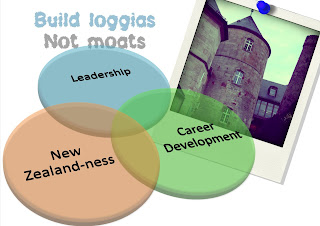Hey - that almost sounds like a Roland the Gunslinger novel!Inger has a great method for deciding what is in, and what is outside your disciplines: she suggests that we create a 'typical' persona for each discipline, and consider what each person would want to know from our work in order to be satisfied that we know our stuff.
My work is going to straddle the gap between leadership, what it means to be a New Zealander, and career development. So I need to create a typical profile of each type of expert.
That makes total sense.
I have used customer profiling often to explain branding and communication issues to my students: John the rugby fan, Sale the league fan etc. I have also used this for clients, in helping them work through who their ideal customer is.
What is really interesting is that, although a lot of it can be 'seat of the pants' instinct (or, as Shaw James, an NMIT colleague terms it: "wild-assed guesses" - WAGs), it is often pretty on the mark. It also gives us a starting place that we can use to further refining our ideas as we find real data and evidence for our WAG.
Inger profiled two possible examiners for her PhD thesis, where her work looked at the use of gesture in architecture: a comms expert and an architecture professor and historian. She created backgrounds, had snapshots of them, and kept those artefacts visible where she was writing. As she said, when "I wrote I would look at the profile and ask myself: 'what would Jurgen think of this?', 'would Johanna agree with that?'" which helped her write to meet the needs of that possible examiner audience.
Inger also noted that Jurgen "would not need to read a whole lot of stuff that Johanna already knew, so I sign-posted it for her, i.e: 'readers familiar with the history of architectural education can safely skip the next chapter and go straight to chapter four where I sketch out the history of research on gesture'."
However, Inger notes that we still need to come to a clear conclusion in our work, and to own our own viewpoint and conclusion. We must need to find clarity in the intersection between the fields and create a synthesis, not recreate the silos in our own work.
I will try work with my silos, focusing on synthesising them and bringing them together into my own mash-up where they can all talk to each other.
Build loggias, not moats :-)
Sam
- Reference: Mewburn, Inger (11 September 2013). Is your PhD a monster? Australia: Thesis Whisperer. Retrieved 17 March 2016 from http://thesiswhisperer.com/2013/09/11/help-i-think-i-have-created-a-monster/


No comments :
Post a Comment
Thanks for your feedback. The elves will post it shortly.